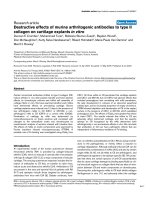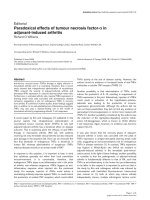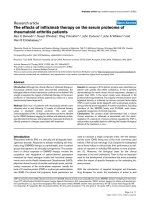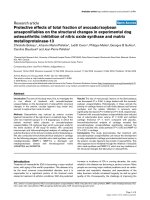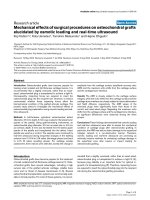Báo cáo y học: "Extrapulmonary effects of nitric oxide inhalation therapy: time to consider new dosing regimes" docx
Bạn đang xem bản rút gọn của tài liệu. Xem và tải ngay bản đầy đủ của tài liệu tại đây (36.01 KB, 1 trang )
Page 1 of 1
(page number not for citation purposes)
Available online />Studies with nitric oxide (NO) inhalation suggest trans-
formation of NO in the lung into a more long-lived bioactive
NO species that also has distal effects [1,2]. The exact
nature of these species has not been pinpointed, but
probable candidates include circulating nitrite anions and/or
S-nitrosothiols [3]. When using inhaled NO therapeutically for
pulmonary disorders, the dose is typically expressed as the
concentration of NO without adjustments for body size.
When inhaling 10 ppm NO, the concentration of NO that
reaches the lungs with every breath is the same whether it in
a mouse, a premature infant or an adult. The minute
ventilation in relation to body weight, however, is about three
to four times higher in a premature infant compared with an
adult, so the resulting accumulation of bioactive NO
metabolites in blood is much greater. This greater
accumulation suggests that the dose of inhaled NO should
be adjusted in relation to body weight, and also calls for
some caution when extrapolating results from animal data to
humans. A concentration of inhaled NO that is effective in a
small animal may therefore not be sufficient in humans.
Conversely, a concentration that is effective and safe in
adults may cause unwanted toxic effects in premature infants.
Several factors will affect the metabolism of inhaled NO into
bioactive circulating NO species. The vast majority of inhaled
NO eventually ends up as nitrate, which is considered
biologically inert. In awake subjects, however, nitrate under-
goes enterosalivary circulation and is reduced to nitrite in the
oral cavity [4]. Swallowed nitrite then reenters the circulation,
where it can be further reduced to bioactive NO [5]. In
intubated sedated patients the enterosalivary nitrate/nitrite
cycle is disrupted, and consequently less nitrite is generated.
The levels of circulating NO species will also depend on NO
oxidation in blood into nitrite, on renal excretion and on the
activity of the reductive systems that ultimately catalyse NO
formation from the circulating NO metabolites [3].
In summary, it is clear that inhaled NO has distal effects
outside the lungs that may be harnessed therapeutically in
the future; for example, in the prevention of ischemia-
reperfusion injury. Although the precise nature of the NO
metabolite(s) responsible for these effects remains to be
pinpointed, there are indications that the nitrite anion plays an
active role. In experimental settings and in future clinical trials
we should consider adjusting the dose of inhaled NO in
relation to body size and should consider other factors that
may affect the transduction of NO bioactivity to the target
organ. Finally, the possibility of delivering the active NO
metabolites directly instead of via NO inhalation should also
be considered.
Competing interests
The authors declare that they have no competing interests.
References
1. Fox-Robichaud A, Payne D, Hasan SU, Ostrovsky L, Fairhead T,
Reinhardt P, Kubes P: Inhaled NO as a viable antiadhesive
therapy for ischemia/reperfusion injury of distal microvascu-
lar beds. J Clin Invest 1998, 101:2497-2505.
2. Cannon RO 3rd, Schechter AN, Panza JA, Ognibene FP, Pease-
Fye ME, Waclawiw MA, Shelhamer JH, Gladwin MT: Effects of
inhaled nitric oxide on regional blood flow are consistent with
intravascular nitric oxide delivery. J Clin Invest 2001, 108:279-
287.
3. Lundberg JO, Weitzberg E, Gladwin MT: The nitrate–nitrite–
nitric oxide pathway in physiology and therapeutics. Nat Rev
Drug Discov 2008, 7:156-167.
4. Lundberg JO, Weitzberg E, Cole JA, Benjamin N: Nitrate, bacte-
ria and human health. Nat Rev Microbiol 2004, 2:593-602.
5. Lundberg JO, Govoni M: Inorganic nitrate is a possible source
for systemic generation of nitric oxide. Free Radic Biol Med
2004, 37:395-400.
Letter
Extrapulmonary effects of nitric oxide inhalation therapy:
time to consider new dosing regimes?
Jon O Lundberg
1
and Eddie Weitzberg
2
1
Department of Physiology and Pharmacology, Karolinska Institutet, Stockholm, Sweden
2
Department of Physiology and Pharmacology, Section of Anaesthesiology and Intensive Care, Karolinska Institutet, Stockholm, Sweden
Corresponding author: Jon Lundberg,
Published: 11 February 2008 Critical Care 2008, 12:406 (doi:10.1186/cc6775)
This article is online at />© 2008 BioMed Central Ltd
NO = nitric oxide.




